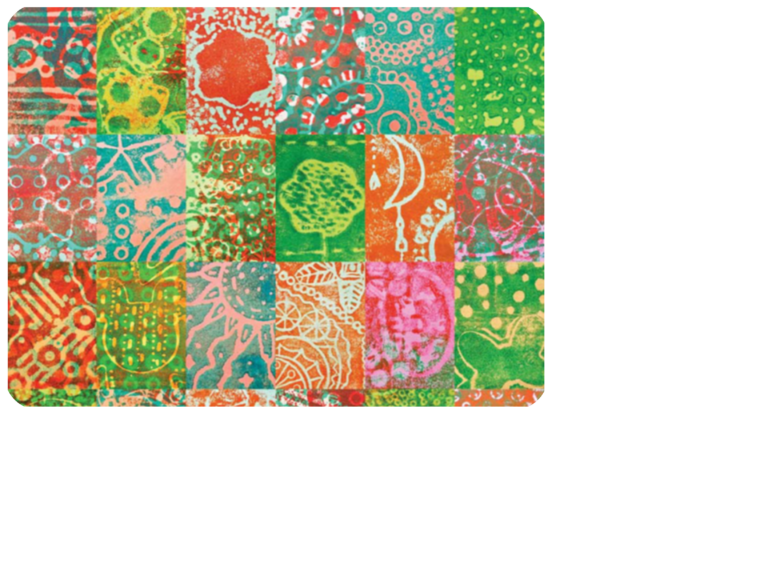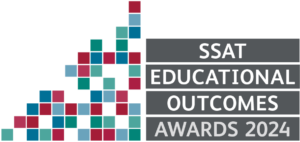Bringing d/Deaf young people together through creativity

Lucy Lester, Teacher of Deaf Children and Young People, shares details of her school’s open event
Art is a subject that most people love, but it can also feel intimidating. The worry of ‘making a mistake’ or ‘getting it wrong’ often limits creativity and passion, both in and outside the classroom. So, when I looked to organise an open event at my school’s d/Deaf Hub, I knew I wanted it to be centred around breaking students out of their creative and social fears. As a qualified art and textiles teacher, I knew art was the perfect creative safe space to make this happen.
Art provides a safe space to make mistakes
I’ve recently finished the first year of my deaf education course at Birmingham University, and I’m relatively new to my role of resident Teacher of Deaf Children and Young People (ToD) at a secondary school in Peterborough, Cambridgeshire. Because of this, I also chose art and creativity as the theme partly because it plays to my strengths and is something I’m comfortable and passionate about. However, I’d suggest an art event to any d/Deaf hub as it provides students with a sadly all-too-rare opportunity: a safe space to make mistakes and fail without consequence. Students (d/Deaf included) are under more exam pressure than ever and the need to be ‘perfect’ is ever-present, so events like this provide the perfect space for them to unwind with their peers within the context of the school grounds.
Planning an art event
To plan out the nitty-gritty of the event, I enlisted the help of our fantastic head of art. We discussed the merits of teaching different artistic techniques and materials – what would help students to relax, explore without pressure, and potentially even make new friends within the d/Deaf community? Ultimately, we settled on Zentangle drawing, which is repeating doodled patterns. We also thought poly-tile printing would be a good way of extending the Zentangle theme and building on what students had just learned. If you’re looking to plan your own event and don’t know where to start, I’d suggest these techniques as a great jumping-off place. We got stuck in straight away and had a go ourselves, took photos of the steps to add into PowerPoint slides, and printed guides for the students to refer to. This was a lot of fun for us and reminded me of my Postgraduate Certificate in Education (PGCE) days, enthusiastically creating teaching resources.

Planning an art event
As ToDs, we all know that the acoustic environment is crucial to our students’ learning.
Before arranging room changes to accommodate the event, I made sure to consider the sound quality. Although it had hard, clacky floors (as art rooms often do), there’s a soundfield system installed in the art classroom to help overcome the potentially poor acoustics of a practical lesson.
Most importantly, if you’re arranging an event for a school d/Deaf hub, it needs to be in the beating heart of the school. Open events like this are an opportunity for children to see the school and d/Deaf hub in-person before committing to joining the school cohort.
For that reason, I also view events like these partly as a marketing exercise.
Making it memorable
Like any good marketing events, d/Deaf hub events need to be easily memorable and make the child feel special. I really wanted each child to leave knowing that this is a school that will care for their needs. To that end, I made ‘goodie bags’ to hand out to each student, filled with donated art and craft supplies, sweets, and a booklet containing guided art activities. This gave them the opportunity to carry on what they learned at home, and hopefully made the experience a bit sweeter. Events aren’t just for children but also for the amazing staff who support them. I decided early on that I wanted to provide the attending students and staff with pre-teaching materials. including key vocabulary with definitions, images and videos, so they’re not walking in on the day unaware of what’s going to happen. It all took a fair bit of planning, but now I’ve done it once, it’s a permanent resource that I can adapt for future years’ events. Finally, I needed to create marketing for the event itself. I sent emails to special educational needs co-ordinators (SENCos) around the local area, called schools, and reached out to peripatetic Qualified Teachers of Deaf Children and Young People (QToDs) to spread the word. Then, I crossed my fingers and prayed that at least one child would show up.
The day of the event
On the day, 12 young people from key stages 2 and 3 arrived. They came from five different schools and brought along 13 teaching assistants, QToDs, and British Sign Language (BSL) interpreters from across Peterborough. When they arrived, the students were nervous (me too!), preferring to sit with those they knew. To help with this, I used a ‘getting to know you’ bingo activity I found on Twinkl and some name labels. Students soon got out of their seats, rushing around to find out who in the room had an older sister, loved swimming or had a pet cat. In the end, the winner was an initially quiet girl, who rushed over to me with her completed sheet ready for her prize. This activity really helped break the ice among not just the younger students, but the adults too; the enthusiasm was infectious. I can’t recommend it enough.
Showcase your colleagues
When we got to the first art activity, I asked the head of art to take the lead as this was an opportunity for the d/Deaf children to meet another friendly face from the school. Everyone was eager to listen to the expert in the room, and, thanks to the pre-teaching resources, students confidently answered questions about the task and enjoyed the relaxing doodle-style Zentangle drawing. The next activity was more complicated: creating a printing plate. I gathered the students around a large front table to observe a teacher demonstration. This worked well as students were able to view the techniques up-close and ask questions together as a group. They then pressed Zentangle-like patterns onto polystyrene using a range of objects, including cookie cutters, pen lids, Duplo blocks, forks, and playdough tools. I also encouraged the support staff – this was a day for them too, after all. This went down well as it was a fun novelty that helped the students get stuck into the task themselves. Seeing some of the staff hold back and struggle with making the first impression into the polystyrene also helped the students see that everyone can be a bit nervous at times about ‘making a mistake’; it’s not just young d/Deaf people who struggle with confidence. When the printing plates were prepared, the head of art gave another demonstration around the front table, showing how to apply ink to the printing plates. She spoke clearly and asked questions to check understanding. In the end, the students were all impressed by her layered print example. The excited “ooohh” she conjured from them is something I miss from back when I taught art myself!
You don’t have to wear a suit to network
After an hour or so, we all went for a break in the school atrium (during lesson time, to ensure it was quiet!). I arranged for tea, coffee, squash and biscuits to be provided. The students and staff enjoyed the opportunity to mingle further, and I enjoyed the opportunity to speak to two prospective students and support the transition of more d/Deaf young people to my school. We returned to the art room ready to print. This was the part I was excited about! Everyone enjoyed the novelty of the technique, and when ready, they donated a piece to be made into a collaborative piece of art. A board was placed on an easel at the front of the class, ready for students to add their own creation with Blu Tack. The rest of the event flew by. At the end, everyone huddled around the board admiring their work. Some students started dancing while waiting for others to arrive. The vibe of the morning was exactly what I’d hoped for, and at two hours long, it was the perfect length. The goodie bags I pre-prepared were gratefully received and a bookmark competition was announced, encouraging the students to email in photos of the art they will create using the included booklets in the goodie bags.
You don’t have to wear a suit to network
When everyone had waved goodbye and the tidying was complete, I had a feeling I could only compare to that of when a good party ends. There was a lot of planning, emailing, and preparation needed to bring everyone and everything together, but thankfully, the feedback from those who attended was overwhelmingly positive. The next day, I sent out a survey to help me improve and plan for future events, and the following week, I initiated conversations with other members of staff who could lead activities from other specialisms. Using the art made at the event, I created bookmarks with quotes from the d/Deaf students I’ve supported on the back. I asked my students what they want people to know about themselves, how to communicate best, what frustrates them, and what they like about their d/Deaf identity. I intend to display the prints created at the event within my school, but having bookmarks is a way for the art and the views of d/Deaf students to be easily shared – and again, it’s a nice piece of marketing for our school’s d/Deaf hub.
Now it’s your turn
I hope this article has inspired you to plan a creative event for d/Deaf young people in your area. Remember: creativity isn’t just limited to artistic subjects, too!

Lucy Lester is a resident ToD and Deaf Hub manager at St John Fisher Catholic High school, Peterborough. After teaching art and textiles for nine years, she decided to have a career change and train as a QToD. Initially hesitant and worried that her passion for bringing creativity to young people would stop, she now strives to bring this opportunity to d/Deaf young people in Peterborough
© 2022 Created by St John Fisher Catholic High School






